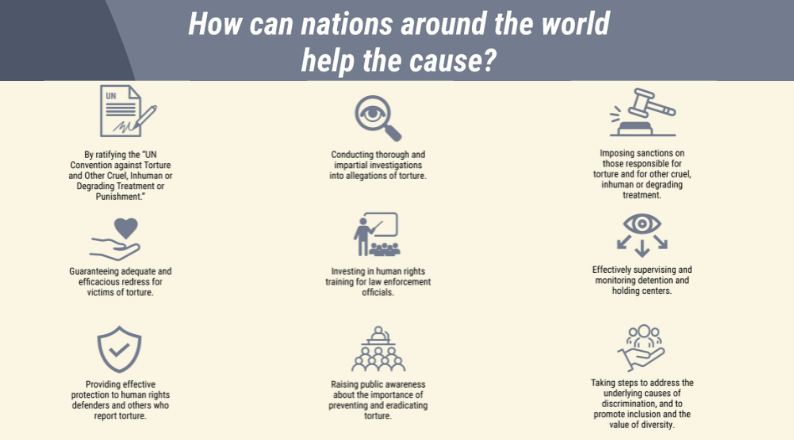(ZENIT News / Vatican City, 05.30.2023).- How is it possible that the human capacity for cruelty is so huge?” Pope Francis asks with horror at the beginning of this month’s Pope Video. The Holy Father’s new prayer intention for June, which is entrusted to the entire Catholic Church through the Pope’s Worldwide Prayer Network, is an appeal for the abolition of torture in all of its forms throughout the world.
History, past and present
“Torture is not past history”, explains Pope Francis in the video. “Unfortunately, it’s part of our history today.” In the words accompanying his prayer intention, he also underlines that, in addition to “extremely violent forms of torture, “other more sophisticated” methods are used in the world today, “such as degrading someone, dulling the senses, or mass detentions in conditions so inhumane that they take away the dignity of the person.”
The timing of his condemnation of the practice, and the prayer intention itself, is not accidental. This upcoming 26th of June is the United Nations International Day in Support of Victims of Torture, for it was on this date in 1987 that the UN Convention Against Torture and Other Cruel, Inhuman or Degrading Treatment or Punishment went into effect. The convention was ratified by 162 countries after its adoption in 1984.
Ecce homo (Behold the man)
Images of prisoners in inhumane conditions – tied to a chair, hooded, hands bound – open the Pope Video this month, which reconstructs places and current practices of torture in various parts of the world. Buckets containing rags, cords, batteries, pliers, hammers, machetes…. This disturbing inventory of an imaginary torture chamber accompanies Pope Francis’s words, in order to emphasize that whoever tries to reduce a person to a “thing” loses his or her own humanity first of all. This is what also happened to those who tortured Jesus, when they scourged him, beat him, mocked him. Jesus experienced torture during his Passion, and died bearing the signs of that torture: the wounds of the thorns and the whips, the bruises from the punches, the welts of the ropes that bound his writs. The video contains closeups of the image of the Ecce homo in the shrine of Mesoraca with this same name, located in Crotone, Italy. These images are impressive because of how real they are.
A prohibited practice that remains in the shadows of international law
Torture is a practice dating back to antiquity. In the 18th and 19th centuries, western countries officially abolished its official use through the judicial system. Today, it is entirely prohibited by international law. Nevertheless, it continues to be practiced in many countries. Since 1981, the United Nations Fund for Victims of Torture has assisted an average of 50,000 victims of torture each year, in countries in every corner of the globe. Of course, torture tends to occur in conflict zones. Such is the case with Russia’s aggression against Ukraine, where there have been reports of acts of torture perpetrated by Russian soldiers against Ukrainian military and civilians. In addition, and in part due to the advent of new technologies, the use of certain non-physical forms of torture, such as psychological torture, has increased. Moreover, aggravating the issue is the persistent lack of accountability for torture and ill-treatment on a global scale, partly caused by systemic denial, the obstruction and the deliberate evasion of responsibility on the part of public authorities which makes it difficult to document and estimate the number of victims.

Pope Francis’s appeal
This, then, is the Pope’s appeal to the entire international community, that it “commit itself concretely to abolish torture, guaranteeing support to victims and their families.” Pope Francis, in a discourse given in 2014, had already pointed out that “these abuses can only be stopped with the firm commitment of the international community to recognize […] the dignity of the human person above everything else.”
Jesus Christ, tortured and crucified
Father Frédéric Fornos S.J., International Director of the Pope’s Worldwide Prayer Network, commented on this intention: “No matter what the reasons are, torture can never be justified. Pope Francis has said this clearly many times. For example: ‘Torturing a person is a mortal sin! Christian communities must commit themselves to helping victims of torture’ (Tweet from 26 June 2018). For Christians, Jesus Christ is the face of God. Throughout history, he has drawn near to all victims of torture through his own Passion. Because of this, as Pope Francis says in Fratelli tutti: ‘Every act of violence committed against a human being is a wound in humanity’s flesh’ (FT 227). This month of prayer and action for the abolition of every form of torture, whether of detainees, prisoners, or abducted persons, is also an appeal to guarantee the ‘support of the victims and their families.’”


